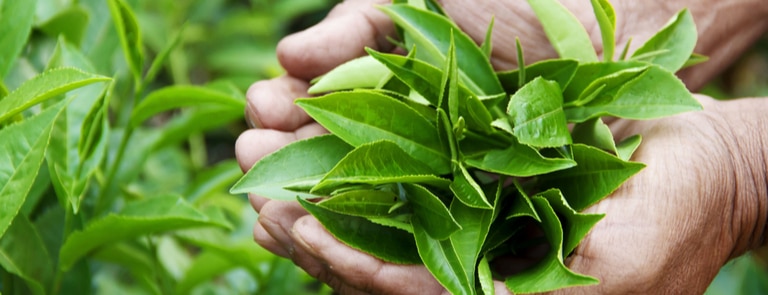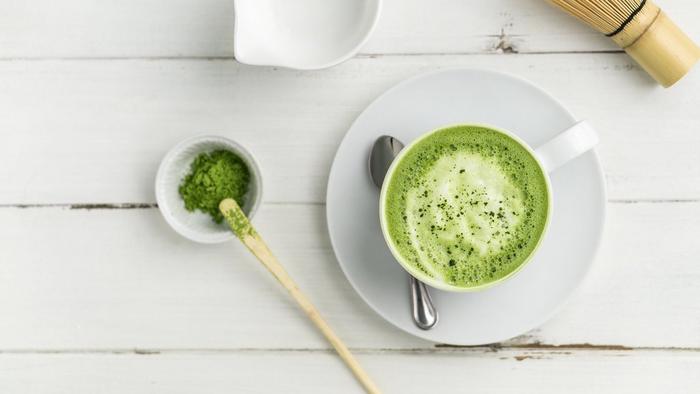The Rise of Matcha: Caffeine Comparison with Tea and Coffee
Source: JapanCentre
In a world increasingly captivated by the pursuit of healthier living and sustainable choices, matcha has surged to prominence not merely as a beverage but as a lifestyle enhancer. With its distinctive vibrant green hue, matcha distinguishes itself from the traditional realms of tea and coffee caffeine. This rise prompts a closer examination of why matcha may indeed offer superior benefits compared to its counterparts, tea, and coffee.
The Natural Essence of Matcha and Its Harvesting Superiority

Source: National Centre for Biotechnology Information
Matcha, sourced from the Camellia sinensis plant, shares its origins with other teas but diverges significantly in its cultivation and processing methods, imbuing it with unique attributes that set it apart from its counterparts. The cultivation process of matcha is distinctively nuanced, involving the tea plants being shrouded from direct sunlight for approximately three to four weeks prior to harvest. This deliberate shading technique boosts the chlorophyll content, endowing matcha with its characteristic deep green coloration and enhancing its nutritional density. The heightened levels of chlorophyll not only contribute to its vibrant hue but also play a vital role in augmenting the tea’s profile of vitamins, minerals, and antioxidants, crafting a beverage that is as nourishing as it is aesthetically pleasing.
The process does not end with the harvest; the leaves undergo a meticulous transformation into matcha. Traditional tea leaves are usually steeped, but matcha’s journey from leaf to powder is more intricate. Each leaf is carefully steamed, stemmed, and stone-ground into a delicate powder. This comprehensive approach to processing ensures that the entirety of the leaf is consumed, allowing drinkers to benefit from the full spectrum of its nutritional offerings. This method distinguishes matcha from traditional teas and coffee, which often involve infusions that leave behind a significant portion of the plant's potential benefits.

Source: Clear Spring
Through this careful and deliberate method of cultivation and processing, matcha transcends its role as a mere beverage. It stands as a testament to the power of thoughtful agricultural practices, showcasing how traditional techniques can yield products of superior quality and nutritional value.
A Comprehensive Look at Caffeine Content

Source: Holland & Barrett
Delving into the caffeine spectrum, matcha positions itself uniquely when juxtaposed with traditional tea and coffee. A standard serving size of matcha harbours approximately 70 milligrams of caffeine, placing it in a sweet spot that is more potent than most teas yet slightly milder than a typical cup of coffee. However, the qualitative experience of caffeine from matcha is where the distinction becomes most evident. This variance primarily stems from the presence of L-theanine within matcha, an amino acid with the capability to modulate the energizing effects of caffeine. The resulting synergy between caffeine and L-theanine in matcha facilitates a smooth, sustained release of energy. This contrasts sharply with the rapid absorption and subsequent crash often associated with coffee consumption.

Source: Downshiftology
The equilibrium achieved through matcha’s caffeine content and its L-theanine levels underscores a pivotal aspect of its appeal. Unlike the abrupt jolt associated with coffee or the subtle lift from traditional tea, matcha offers an elongated curve of alertness and vitality. This unique caffeine delivery system ensures that individuals can enjoy the invigorating effects of their beverage without succumbing to the nervous energy or post-caffeine lethargy frequently reported by coffee drinkers. Consequently, matcha emerges as a compelling alternative for those seeking the benefits of caffeine without the less desirable side effects that can disrupt daily functioning and well-being. Through this lens, matcha's caffeine content is not just a matter of quantity but, more importantly, a matter of quality and the overall experience it fosters.
The Synergy of Matcha's Components and Its Impact on Well-being

Source: SleepFoundation
The synergistic relationship between matcha's caffeine and L-theanine underpins a remarkable impact on individual well-being, distinguishing it significantly from the effects observed with traditional tea and coffee consumption. This blend of components facilitates a unique mental state characterized by enhanced clarity and focus. The presence of L-theanine, a notable amino acid in matcha, plays a pivotal role in moderating the stimulating effects of caffeine. This moderation leads to the generation of alpha wave activity in the brain, a condition associated with calm yet alert states of consciousness.
This gentle coaxing of the mind into a state of calm alertness fosters an environment where productivity and mental acuity flourish without the accompaniment of agitation or restlessness often seen with high caffeine intake from other sources. Such a state proves invaluable for tasks requiring prolonged concentration and creativity, offering a sustained energy that nurtures the body's natural rhythms rather than disrupting them.
Moreover, the interaction between caffeine and L-theanine in matcha extends beyond immediate cognitive benefits. It influences long-term well-being by promoting a balanced approach to energy consumption. Rather than experiencing the peaks and troughs of energy associated with coffee, matcha consumers enjoy a more even-keeled vitality. This steadiness contributes to a reduction in stress levels and an improvement in overall mental health, marking matcha not just as a beverage but as a vital component of a mindful lifestyle aimed at maintaining and enhancing well-being. Through the lens of matcha, one witnesses the profound impact that the thoughtful combination of natural components can have on human health and performance.
Antioxidant Powerhouse: Matcha’s Protective Benefits

Source: Healthline
The acclaim that matcha garners as a potent source of antioxidants is well-founded, with its unparalleled density of catechins standing at the forefront of its nutritional profile. Among these, epigallocatechin gallate (EGCG) is especially noteworthy, constituting a substantial portion of matcha's catechin content. The prominence of EGCG in matcha is not merely a numerical superiority but translates into tangible health benefits. Research has linked this potent antioxidant to a myriad of protective effects against chronic diseases, spotlighting its role in mitigating the risk factors associated with heart disease, type 2 diabetes, and various cancers. The distinct advantage matcha holds over other green teas in terms of EGCG concentration can be traced back to its unique cultivation and consumption practices. By consuming the entire leaf in powdered form, individuals ingest a fuller complement of the leaf's natural compounds, maximizing the health-promoting potential of matcha.
This rich antioxidant profile does more than shield the body from specific diseases. It engages in a broader protective role, combating oxidative stress and reducing inflammation. These mechanisms are pivotal in maintaining cellular health and preventing the onset of a wide range of health issues, from aging-related conditions to more acute forms of illness. The robust antioxidant capacity of matcha thus positions it not only as a beverage of choice for those seeking immediate health benefits but also as a strategic inclusion in a long-term wellness regimen. Through its impressive array of protective antioxidants, matcha demonstrates a profound capacity to contribute to sustained health and vitality, offering a compelling argument for its favoured status among health-conscious individuals.
Sustainability and the Environmental Footprint of Matcha Production

Source: Matchawellness
The cultivation practices associated with matcha production set a standard for environmental consciousness in the agricultural domain. The traditional shade-grown technique, essential for matcha's development, fosters a harmonious relationship with nature. This method not only enriches the matcha with its renowned nutritional benefits but also supports ecological well-being by encouraging the preservation of natural habitats. Unlike the intensive farming methods often observed in the production of coffee and conventional tea, which can lead to significant ecological strain, matcha cultivation emphasizes a more balanced and sustainable interaction with the environment.
By nurturing the tea plants in shaded conditions, farmers minimize the need for artificial aids, thereby reducing the reliance on chemical fertilizers and pesticides that can disrupt local ecosystems. This approach demonstrates a commitment to organic farming principles, reinforcing the role of matcha production in promoting agricultural sustainability. Moreover, the careful management of matcha plantations helps in maintaining soil health and integrity, preventing erosion, and protecting water resources – critical components of environmental stewardship.
In the broader context of global agricultural practices, the matcha production process exemplifies how traditional cultivation techniques can offer modern solutions to sustainability challenges. It serves as a model for other agricultural sectors, showcasing the possibility of achieving high-quality produce without compromising the health of our planet. Through its sustainable production methods, matcha not only provides a healthful beverage option but also contributes to the greater good of environmental conservation, illustrating the profound impact mindful agricultural practices can have on the world.
The Versatility of Matcha in Culinary Endeavours

Source: Bbcgoodfood
Matcha's ability to transcend the boundaries of a mere beverage and embed itself within the culinary landscape speaks volumes about its adaptability and appeal. The unique flavour profile of matcha, characterized by its rich umami coupled with subtle sweetness, makes it a sought-after ingredient in a wide array of dishes. This adaptability has opened the doors for chefs and home cooks alike to experiment with matcha, incorporating it into everything from sophisticated pastries and desserts to energizing smoothies and healthful breakfast bowls. The vibrant green hue that matcha imparts to foods is not just visually striking but also indicative of the nutritional enrichment it provides, adding a layer of health benefits to each dish it graces.
Matcha's culinary versatility extends to savoury applications as well, where its distinct flavour can balance or enhance a variety of recipes. Its powder form is particularly convenient, allowing for easy integration into sauces, dressings, and even marinades, infusing dishes with its unique taste and nutritional profile. This versatility challenges the conventional perception of matcha as solely a tea, positioning it as a dynamic ingredient that elevates the nutritional value and sensory appeal of a broad spectrum of culinary creations.
The embrace of matcha in culinary endeavours also reflects a broader trend towards the incorporation of functional foods into everyday diets. As individuals seek out food experiences that are not only enjoyable but also beneficial to their health, matcha stands out as a multifaceted ingredient that meets these criteria. Its ability to blend seamlessly into both traditional and innovative recipes underscores the growing recognition of its culinary potential and its role in fostering a holistic approach to nutrition and well-being.
The Ritualistic and Mindful Practice of Matcha Preparation

Source: Medium
The art of preparing matcha transcends the mere act of creating a beverage; it is an immersive ritual that embodies tranquillity, mindfulness, and respect. This ceremonious method, deeply rooted in Japanese culture, involves a series of steps that foster an intimate connection with the process. Beginning with the careful measurement of matcha powder, the preparation unfolds as the powder is then whisked with water, transforming into a frothy, vibrant concoction. Each motion, from the selection of the bowl to the rhythmic whisking, is performed with deliberate attention, encouraging a presence of mind often lost in today’s hurried world.
This mindful preparation does more than just yield a cup of matcha; it invites individuals to partake in a moment of serenity and reflection. It is an opportunity to appreciate the beauty in simplicity, the richness of tradition, and the nourishing qualities of the tea itself. The practice serves as a gentle reminder of the value of slowing down, offering a contrast to the rapid pace of modern life and the instant gratification that it frequently demands.
Not only does this ritual enhance the experience of consuming matcha, but it also amplifies its health benefits. The act of engaging fully in the preparation process can have a calming effect, reducing stress and promoting mental clarity. In essence, the ritual of matcha preparation is a form of meditation in motion, a path to cultivating mindfulness and enhancing one’s overall sense of well-being.
By embracing the traditional practice of preparing matcha, individuals connect with a centuries-old tradition that enriches the spirit as much as it does the body. It stands as a testament to the power of mindful living and the profound impact that it can have on daily life.
